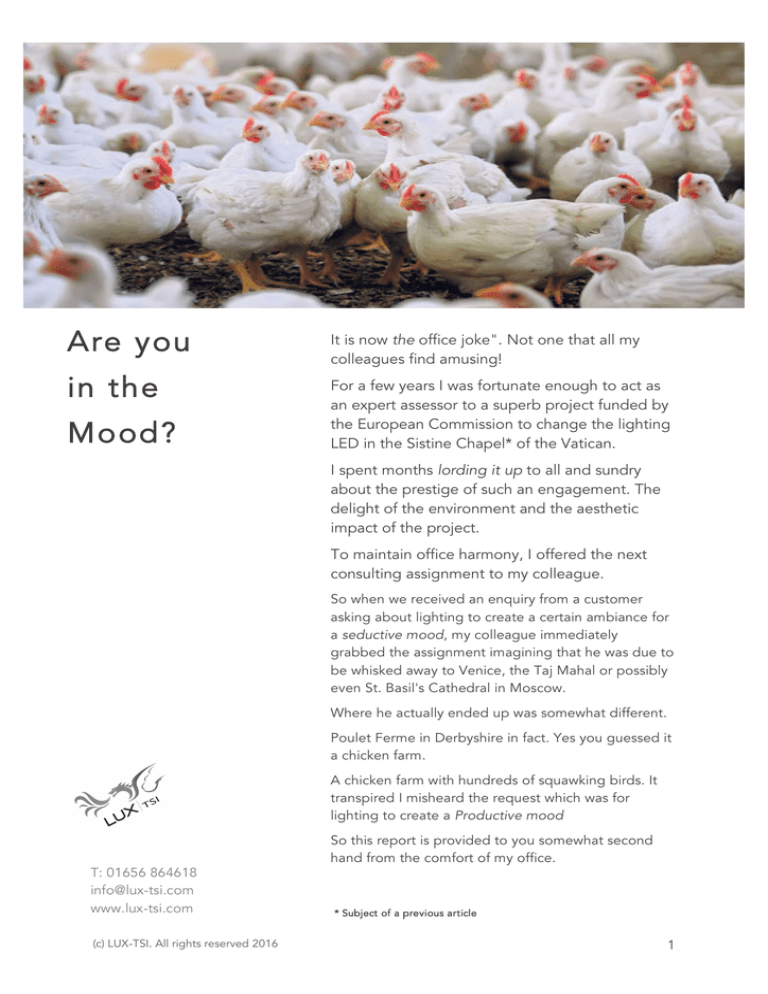
Are you
in the
Mood?
It is now the office joke". Not one that all my
colleagues find amusing!
For a few years I was fortunate enough to act as
an expert assessor to a superb project funded by
the European Commission to change the lighting
LED in the Sistine Chapel* of the Vatican.
I spent months lording it up to all and sundry
about the prestige of such an engagement. The
delight of the environment and the aesthetic
impact of the project.
To maintain office harmony, I offered the next
consulting assignment to my colleague.
So when we received an enquiry from a customer
asking about lighting to create a certain ambiance for
a seductive mood, my colleague immediately
grabbed the assignment imagining that he was due to
be whisked away to Venice, the Taj Mahal or possibly
even St. Basil's Cathedral in Moscow.
Where he actually ended up was somewhat different.
Poulet Ferme in Derbyshire in fact. Yes you guessed it
a chicken farm.
A chicken farm with hundreds of squawking birds. It
transpired I misheard the request which was for
lighting to create a Productive mood
T: 01656 864618
info@lux-tsi.com
www.lux-tsi.com
(c) LUX-TSI. All rights reserved 2016
So this report is provided to you somewhat second
hand from the comfort of my office.
* Subject of a previous article
1
For readers of my previous column in Lux Magazine
know I have written to try to simplify much about
light. Lights in offices, lights when driving, lights
during the day, light at night, light in almost every
situation of human endeavour.
I have written about lumens, I’ve written about glare,
I’ve written about rods, cones, scotopic/ photopic
ratios. But what I have never written about was that
light suitable for humans was not necessarily good for
other creatures.
Although it’s really rather obvious. We all know about
an owls’ ability to see at night is far superior to ours or
a bees view in the black light of ultra-violet.
But what is not obvious is that the spectral sensitivity
of the eye of a chicken is far superior to ours. In fact
humans only see about 40 percent or so of what the
chicken actually sees.
Not that I want to turn this into an anatomical
lesson but it important to understand how
chickens see.
Chickens like humans have eyes comprising a
cornea and iris, which focus light onto nerve
endings in the retina at the back of the eyeball.
That’s where the similarities end as chicken’s
eyes evolved differently in four distinct ways.
First, chickens can see in the UltraViolet
spectrum. Whilst humans have tri-chromatic
vision (3 wavelengths - red, green and blue),
Chickens have tetra-chromatic (UV plus RGB).
The implications of which are astonishing. We as
humans we have no concept or experience of
what vision in this sector of the light spectrum
looks like.
Chicken eye is x25 times larger than a
human eye in proportion to head size
Everything they see looks different. We have no
description or vocabulary for how much UV is
reflected from any substance.
The 4 peaks of sensitivities of the
chicken eye.....they see UV light (grey
line), as well as all the colours we see
(c) LUX-TSI. All rights reserved 2016
2
To demonstrate this point, as far as it is possible, we
have a picture of cockatiel. Males and female
cockatiels look the same to us, but under UV light,
something else appears. The picture on the left is
human sight. The picture in the middle is the UV
spectrum only. The right hand picture is a rendering
that approximates how another bird would sense
that bird.
Second, chickens have different type of, and
different number of cones and rods. Rods enable us
to see light intensity and cones - colour. In humans
there are 2.5 rods to every cone.
Chickens have very few cones, and the ones they do
have are not especially sensitive, explaining why
chickens have poor night vision*
Left: bird and egg the way RGB eyes
see them….
Center: UV reflection of the same bird
and egg….
Right: What a chicken sees….
Bird’s colour vision is also different from ours due to
coloured filters mixed in with their nerve cells.
These are little coloured drops of oil which filter out
different wavelengths, acting in a similar manner to
wearing yellow goggles when skiing on a bright day;
the contrast is enhanced.
Imagine then wearing yellow and blue and red goggles
all at the same time. It increases contrast and brightness
and sensitivity, all at once, and we mammals can’t even
imagine what it might look like.
Third, chickens have a double cone structure in their
retina - given them a superior ability to sense
movement.
Fourth, chickens have not one but two fovea! A fovea is
a small pit in the back of retina which act as an image
enlarger.
You can see yours in action by looking at something out
of the corner of your eye, then looking at it directly in
front of you. It’s clearer in front of you. It explains why
you look slightly down at anything you are
concentrating on (the fovea is a little above the middle
of the retina).
Each of the chicken’s fovea have different jobs. One is
for seeing objects at distance; the other for objects up
close. In effect acting as built-in bifocals.
(c) LUX-TSI. All rights reserved 2016
This difference between rod to
cone ratio, and the light
sensitivities of cones in birds vs.
mammals is explained by
evolution.
When the asteroid hit our planet
mammals all but disappeared,
with those surviving being
nocturnal and insect eaters.
In the millennia that ensued,
Mammals re-developed colour
vision.
Birds, as a direct decent of
dinosaurs evolved their cones
from a different starting point
having never spent time buried
away.
3
They are also in different positions within the
cornea. The near distant one is oval shaped and
to the side. The far distant one more central.
This explains the bobbing motion of their heads.
When they get to the focal distance of about 24 feet, birds need to tilt their heads sideways to
get the image better lined up on the second
fovea.
This is what you look like to a chicken....or
at least a good guess
This explains why hens “spook” when
somebody makes a sudden movement, and why
one bird jumping from something can cause the
entire flock to take wing, even if they didn’t see
the offending stimulus.
Birds actually can’t reliably recognize flock
mates until they are within about 24 inches.
So given this biology lesson, what does it mean
for the light we need to provide to our fine
feathered friends?
Well essentially for years we got it all wrong.
Many poultry farmers today continue to do so.
Lighting using traditional incandescent or
fluorescent lighting causes large amount of
stress because the light optimized for our eyes is
not for theirs - for all the anatomical reasons
given above.
The optimal light conditions are especially hard
to achieve in poultry farming: too much light
causes stress, too little it encourages the birds to
lay eggs on the floor instead of nest boxes.
The first aspect to note is the flicker effect of
fluorescent lights. Fluorescent lights can flicker at
100-110hz and upto a few kHz – well above what
we see. But because of the combined action of
the chicken’s double cone and Fovea, this for
them is equivalent to a dance club with strobe
lights. It is exceptionally annoying. It drives them
nuts…literally.
Chickens ideally need a system operating at
50,000 hertz; with much higher frequency, there
is no risk of any flickering.
(c) LUX-TSI. All rights reserved 2016
4
The next aspect is the difficulty associated in
getting the colour is right. Chickens as
mentioned earlier see UV as well as visible light.
Under certain lighting conditions, chickens
mistake the comb on top of other chicken’s head
as food. They literally start pecking each other to
death! I mentioned earlier that chickens have
superior eyesight not intellect!
* actually even blind birds ‘see’
light.
Birds reproductive cycles are
controlled by their pineal gland,
which is located in the middle of
the bird’s forehead, just under the
skull.
Chickens need an environment where the light
spectrum that is much closer to that of sunlight
ideal for mimicking the natural influence that
daylight has on a hen's ability to produce an
egg.
The skull is thin enough that
reasonably bright light penetrates it
and will still stimulate the hormone
cascade that begins lay.
Even blind chickens can “see”
spring coming.
Chickens naturally lay eggs when they get 14
hours of light a day. So the trick is to ensure the
birds keep thinking it's spring and summer*
Armed with this knowledge and superior
‘tunable’ LED technology, such as ALIS from
Greengage Lighting, we are now in position to
deliver the right light for egg laying chickens.
Our colleague spent a wonderful time armed
with photometric meter measuring light at all
positions within the coup to ensure this was just
so. He can happily report he was not pecked
once!
Our scientists also predicted the efficacy of the
light not using the human lumen but the chicken
lumen to ensure it passed essential European
regulations.
Just remember, even if you and your
chickens can see eye-to-eye, you still won’t
see what they see.
Keep this in mind when you try to figure
out why they do what they do!
Additional contribution from:
John Matcham, Greengage Lighting Ltd
T: 01656 864618
info@lux-tsi.com
www.lux-tsi.com
(c) LUX-TSI. All rights reserved 2016
Dr Paul Miller, National Physical Laboratory (NPL)
Poultry farmer, Andrew Watson.
Mike the Chicken Vet
5




